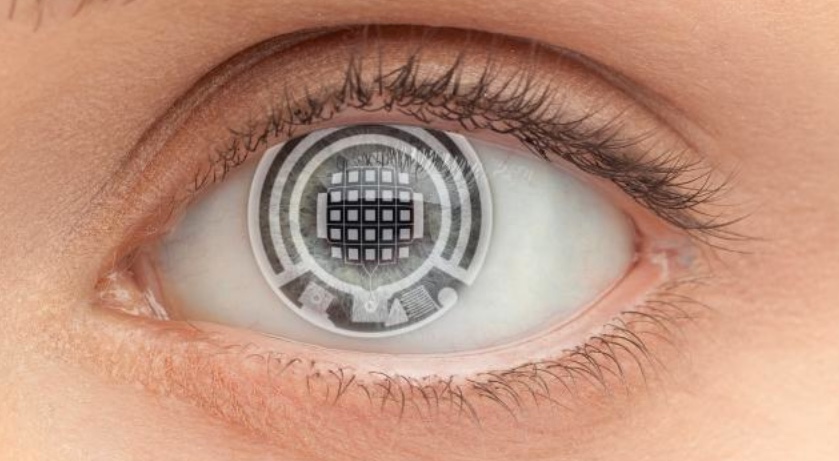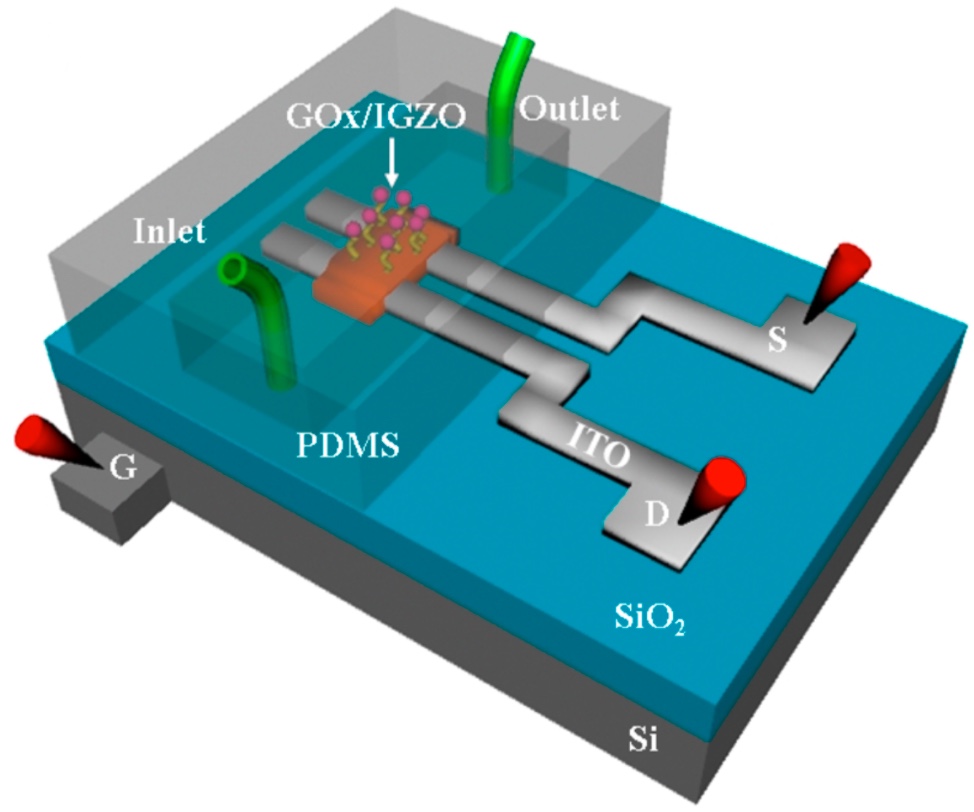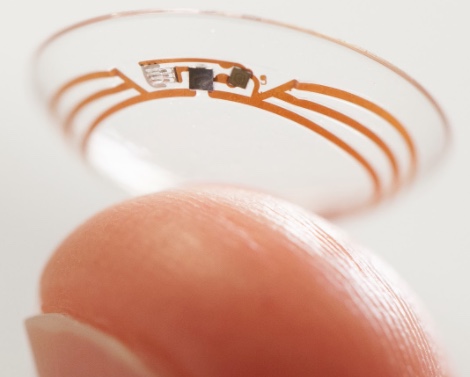This contact lens could someday measure blood glucose and other signs of disease
April 5, 2017

Transparent biosensors in contact lenses (made visible in this artist’s rendition) could soon help track our health. (credit: Jack Forkey/Oregon State University)
Transparent biosensors embedded into contact lenses could soon allow doctors and patients to monitor blood glucose levels and many other telltale signs of disease from teardops without invasive tests, according to Oregon State University chemical engineering professor Gregory S. Herman, Ph.D. who presented his work Tuesday April 4, 2017 at the American Chemical Society (ACS) National Meeting & Exposition.
Herman and two colleagues previously invented a compound composed of indium gallium zinc oxide (IGZO). This semiconductor is the same one that has revolutionized electronics, providing higher resolution displays on televisions, smartphones and tablets while saving power and improving touch-screen sensitivity.
In his research, Herman’s goal was to find a way to help people with diabetes continuously monitor their blood glucose levels more efficiently using bio-sensing contact lenses. Continuous glucose monitoring — instead of the prick-and-test approach — helps reduce the risk of diabetes-related health problems. But most continuous glucose monitoring systems require inserting electrodes in various locations under the skin. This can be painful, and the electrodes can cause skin irritation or infections.
Herman says bio-sensing contact lenses could eliminate many of these problems and improve compliance since users can easily replace them on a daily basis. And, unlike electrodes on the skin, they are invisible, which could help users feel less self-conscious about using them.

A schematic illustration of an experimental device (credit: Du X et al./ ACS Applied Materials & Interfaces)
To test this idea, Herman and his colleagues first developed an inexpensive method to make IGZO electronics. Then, they used the approach to fabricate a biosensor containing a transparent sheet of IGZO field-effect transistors and glucose oxidase, an enzyme that breaks down glucose. When they added glucose to the mixture, the enzyme oxidized the blood sugar. As a result, the pH level in the mixture shifted and, in turn, triggered changes in the electrical current flowing through the IGZO transistor.
In conventional biosensors, these electrical changes would be used to measure the glucose concentrations in the interstitial fluid under a patient’s skin. But glucose concentrations are much lower in the eye. So any biosensors embedded into contact lenses will need to be far more sensitive. To address this problem, the researchers created nanostructures within the IGZO biosensor that were able to detect glucose concentrations much lower than found in tears.*
In theory, Herman says, more than 2,000 transparent biosensors — each measuring a different bodily function — could be embedded in a 1-millimeter square patch of an IGZO contact lens. Once developed, the biosensors could transmit vital health information to smartphones and other Wi-Fi or Bluetooth-enabled devices.
Herman’s team has already used the IGZO system in catheters to measure uric acid, a key indicator of kidney function, and is exploring the possibility of using it for early detection of cancer and other serious conditions. However, Herman says it could be a year or more before a prototype bio-sensing contact lens is ready for animal testing.

(credit: Google)
The concept appears similar to Goggle’s smart contact lens project, using a tiny wireless chip and miniaturized glucose sensor that are embedded between two layers of soft contact lens material, announced in 2014, but Herman says the Google design is more limited and that the research has stalled.
Herman acknowledges funding from the Juvenile Diabetes Research Foundation and the Northwest Nanotechnology Infrastructure, a member of the National Nanotechnology Coordinated Infrastructure, which is supported by the National Science Foundation.
* “We have functionalized the back-channel of IGZO-FETs with aminosilane groups that are cross-linked to glucose oxidase and have demonstrated that these devices have high sensitivity to changes in glucose concentrations. Glucose sensing occurs through the decrease in pH during glucose oxidation, which modulates the positive charge of the aminosilane groups attached to the IGZO surface. The change in charge affects the number of acceptor-like surface states which can deplete electron density in the n-type IGZO semiconductor. Increasing glucose concentrations leads to an increase in acceptor states and a decrease in drain-source conductance due to a positive shift in the turn-on voltage. The functionalized IGZO-FET devices are effective in minimizing detection of interfering compounds including acetaminophen and ascorbic acid.” — Du X, Li Y, Motley JR, Stickle WF, Herman GS, Glucose Sensing Using Functionalized Amorphous In-Ga-Zn-O Field-Effect Transistors. ACS Applied Materials & Interfaces. 2016 03 30.
Abstract of Implantable indium gallium zinc oxide field effect biosensors
Amorphous indium gallium zinc oxide (IGZO) field effect transistors (FETs) are a promising technology for a wide range of electronic applications including implantable and wearable biosensors. We have recently developed novel, low-cost methods to fabricate IGZO-FETs, with a wide range of form factors. Attaching self-assembled monolayers (SAM) to the IGZO backchannel allows us to precisely control surface chemistry and improve stability of the sensors. Functionalizing the SAMs with enzymes provides excellent selectivity for the sensors, and effectively minimizes interference from acetaminophen/ascorbic acid. We have recently demonstrated that a nanostructured IGZO network can significantly improve sensitivity as a sensing transducer, compared to blanket IGZO films. In Figure (a) we show a scanning electron microscopy image of a nanostructured IGZO transducer located between two indium tin oxide source/drain electrodes. In Figure (b) we show an atomic force microscope image of the close packed hexagonal IGZO nanostructured network (3×3 mm2), and Figure (c) shows the corresponding height profile along the arrow shown in (b). We will discuss reasons for improved sensitivity for the nanostructured IGZO, and demonstrate high sensitivity for glucose sensing. Finally, fully transparent glucose sensors have been fabricated directly on catheters, and have been characterized by a range of techniques. These results suggest that IGZO-FETs may provide a means to integrate fully transparent, highly-sensitive sensors into contact lenses.